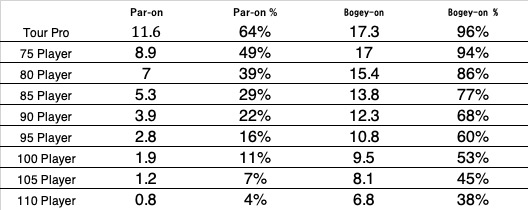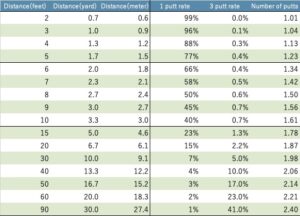Many golfers keep track of their scores and check their par on percentage and bogey-on percentage for each round, but few golfers know what par on percentage and bogey-on percentage they should aim for to cut their score.
The following data is from Marke Broadie’s “Every Shot Counts” and is a rough guide to par-on percentage and bogey-on percentage by score.

What should golfers in the 90s and 100s track, their par on percentage or their bogey on percentage?
Here is a graph of this data.

The bogey-on rate increases linearly (linearly) as the score improves, while the par-on rate is an exponential curve that increases dramatically as the score improves.
The par on rate rises sharply at around 80, but the rate of increase up to that point is slow.
In contrast, the bogey-on rate rises almost in proportion to the score, except for golfers in the 70s.
So, if you set your goal as a par on percentage, you will not be able to feel the improvement immediately.
After all, it is very important to experience success in order to improve.
If you are a 90 or 100 golfer, it is more difficult to improve your par on percentage than it is to improve your bogey on percentage.
In other words, you should focus on your bogey-on percentage and set your goals.
If you want to get under 90, you need to bogey on at 77%.
That’s about 14 times in 18 holes, or about 7 times in 9 holes.
If you want to get under 100, bogey on at 60%.
If you want to get under 100, you should aim to bogey 60% of the time, about 10 times in 18 holes and about 5 times in 9 holes.
I think many amateur golfers have been chasing the par on rate, but if you analyze the data and visualize it, you will clearly understand that it is better to aim for the bogey on rate.
Even in day-to-day business, a relatively simple data analysis and visualization can dramatically improve your business.



Comments